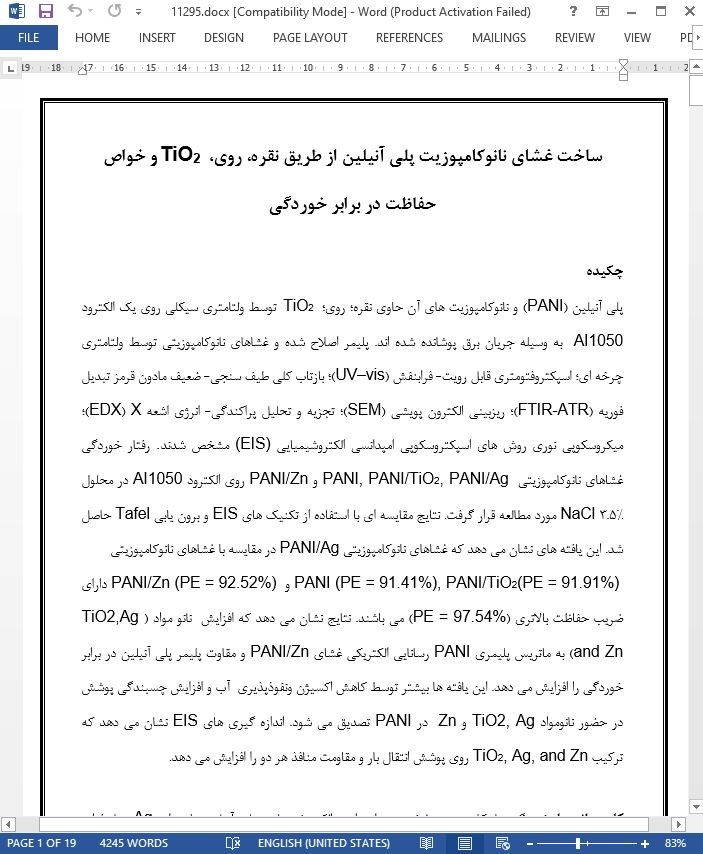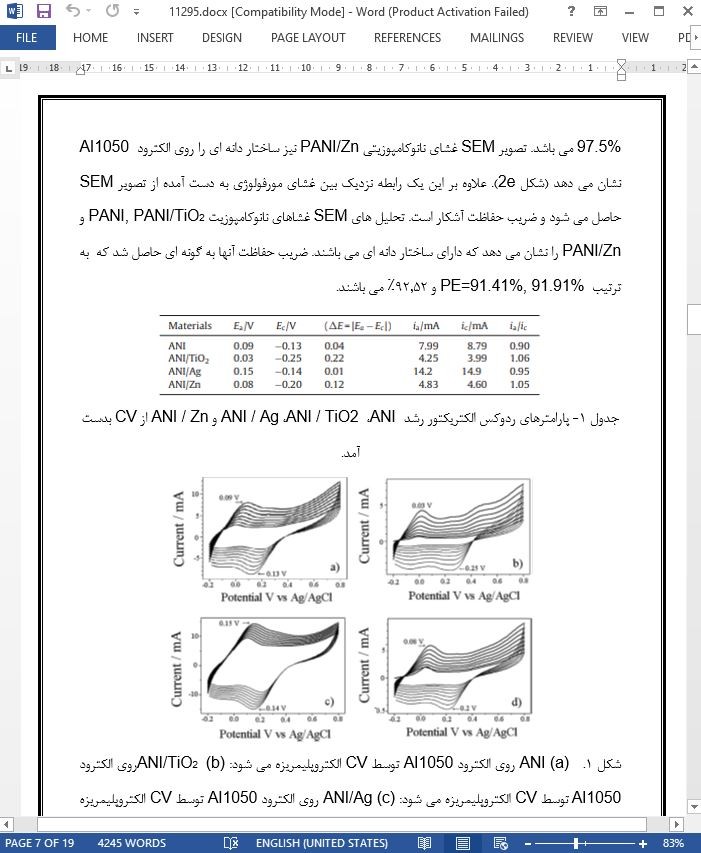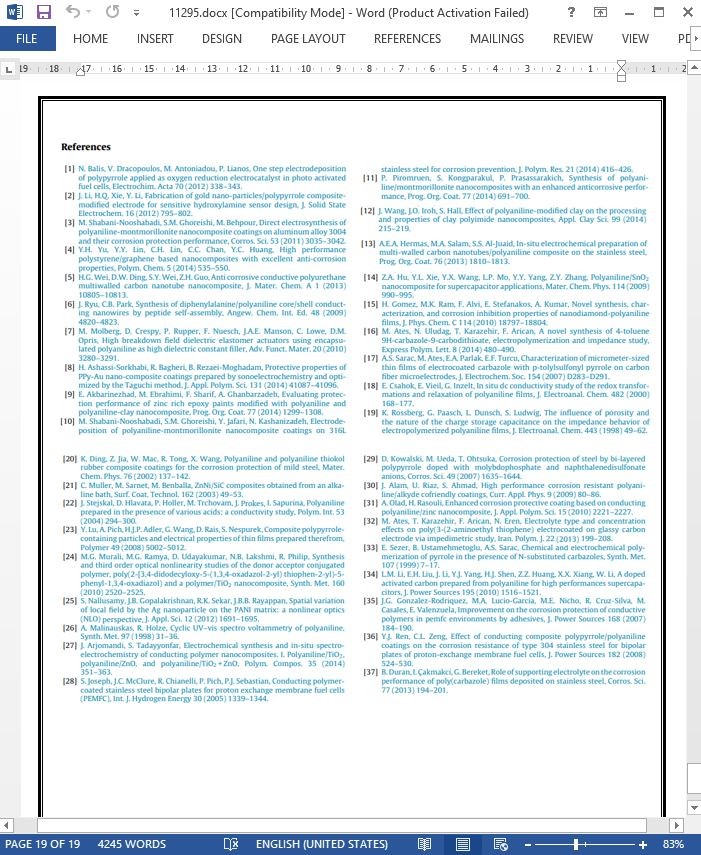
ساخت غشای نانوکامپوزیت پلی آنیلین از طریق نقره، روی، TiO2
چکیده
پلی آنیلین (PANI) و نانوکامپوزیت های آن حاوی نقره؛ روی؛ TiO2 توسط ولتامتری سیکلی روی یک الکترود AI1050 به وسیله جریان برق پوشانده شده اند. پلیمر اصلاح شده و غشاهای نانوکامپوزیتی توسط ولتامتری چرخه ای؛ اسپکتروفتومتری قابل رویت- فرابنفش (UV–vis)؛ بازتاب کلی طیف سنجی- ضعیف مادون قرمز تبدیل فوریه (FTIR-ATR)؛ ریزبینی الکترون پویشی (SEM)؛ تجزیه و تحلیل پراکندگی- انرژی اشعه X (EDX)؛ میکروسکوپی نوری روش های اسپکتروسکوپی امپدانسی الکتروشیمیایی (EIS) مشخص شدند. رفتار خوردگی غشاهای نانوکامپوزیتی PANI, PANI/TiO2, PANI/Ag و PANI/Zn روی الکترود AI1050 در محلول 3.5% NaCl مورد مطالعه قرار گرفت. نتایج مقایسه ای با استفاده از تکنیک های EIS و برون یابی Tafel حاصل شد. این یافته های نشان می دهد که غشاهای نانوکامپوزیتی PANI/Ag در مقایسه با غشاهای نانوکامپوزیتی PANI (PE = 91.41%), PANI/TiO2(PE = 91.91%) و PANI/Zn (PE = 92.52%) دارای ضریب حفاظت بالاتری (PE = 97.54%) می باشند. نتایج نشان می دهد که افزایش نانو مواد (TiO2,Ag and Zn) به ماتریس پلیمری PANI رسانایی الکتریکی غشای PANI/Zn و مقاوت پلیمر پلی آنیلین در برابر خوردگی را افزایش می دهد. این یافته ها بیشتر توسط کاهش اکسیژن ونفوذپذیری آب و افزایش چسبندگی پوشش در حضور نانومواد TiO2, Ag و Zn در PANI تصدیق می شود. اندازه گیری های EIS نشان می دهد که ترکیب TiO2, Ag, and Zn روی پوشش انتقال بار و مقاومت منافذ هر دو را افزایش می دهد.
1. مقدمه
پلیمرهای رسانا همچون پلی آنیلین (PANI)؛ پلی پیرول (PPy) یا پلی تیوفن (PTh) در کاربردهای صنعتی مثل باتری های قابل شارژ [1]؛ سنسورها [2] و حفاظت در برابر خوردگی [3–5] کاربرد دارند. پلی آنیلین یک پلیمر رسانا است که به طور گسترده مورد مطالعه قرار گرفته است به طوری که اعتقاد بر این است که برای کاربردهای نوری و الکتریکی دارای پتانسیل می باشد , و به دلیل شیمی ساده و قابل برگشت تغلیظ/ عدم تغلیظ که قادر به کنترل چندین خاصیت از جمله رسانایی الکتریکی؛ حجم آزاد و فعالیت نوری [6,7] می باشد. بار ذخیره شده در لایه پلیمر در طول واکنش های اکسیداسیون می تواند به صورت برگشت ناپذیر مصرف شود و توانایی حفاظت در برابر خوردگی در طول زمان ممکن است از بین رود [8].
4. نتیجه گیری
در این مقاله پوشش های نانوکامپوزیت PANI, PANI/Zn, PANI/TiO2 و PANI/Ag روی یک زیرلایه Al1050 در یک محلول آبی H2SO4 0.5M شامل 0.4 M آنیلین و 1% نانوذرات تحت امواج فراصوت الکتروپلیمریزه شدند. روش CV برای آماده سازی نانوذرات TiO2,Ag و Zn در حضور PANI با موفقیت مورد استفاده قرار گرفت. الکترود اصلاح شده توسط روش های برون یابی FTIR-ATR, SEM-EDX, EIS و Tafel مشخص شد. نانوکامپوزیت های PANI, PANI/Zn, PANI/TiO2 و PANI/Ag برای حفاظت از خوردگی در برابر محلول 3.5% NaCl روی Al1050 آزمایش شدند. بالاترین ضریب حفاظت برای غشای نانوکامپوزیت PANI/Ag (PE = 97.54%) حاصل شد. بر اساس نتایج آزمون خوردگی می توان نتیجه گرفت یافته های CV, SEM و EIS نتایج برون یابی Tafel را پشتیبانی می کند بنابراین تایید می کند که غشاهای نانوکامپوزیت PANI/Ag بالاترین ویژگی حفاظت را دارند. بنابراین ثابت می کنیم که غشاهای نانوکامپوزیت PANI/Ag می تواند به عنوان مواد حفاظتی برای باتری و دستگاه های ابرخازنی که نوید تکنولوژی تولید برق را می دهند مورد استفاده قرار بگیرد.
Abstract
Polyaniline (PANI) and its nanocomposites containing TiO2, Ag, and Zn were electrocoated on an Al1050 electrode by cyclic voltammetry. The modified polymer and the nanocomposite films were characterized by cyclic voltammetry (CV), ultraviolet–visible spectrophotometry (UV–vis), Fourier-transform infrared spectroscopy-attenuated total reflectance (FTIR-ATR), scanning electron microscopy (SEM), energy-dispersion X-ray analysis (EDX), optical microscopy and electrochemical impedance spectroscopic (EIS) methods. The corrosion behavior of the PANI, PANI/TiO2, PANI/Ag and PANI/Zn nanocomposite films on an Al1050 electrode was studied in a 3.5% NaCl solution. The comparison results were obtained by applying Tafel extrapolation and EIS techniques. The findings indicate that PANI/Ag nanocomposite films yielded higher protection efficiency (PE = 97.54%) compared to PANI (PE = 91.41%), PANI/TiO2 (PE = 91.91%), and PANI/Zn (PE = 92.52%) nanocomposite films. The results show that the addition of nano-materials (TiO2, Ag and Zn) into the polymer matrix of PANI enhanced the electrical conductivity of the PANI/Zn film and the corrosion resistance of the polyaniline polymer. These findings were further confirmed by decreasing the oxygen and water permeability and increasing coating adhesion in the presence of TiO2, Ag and Zn nanomaterials in the PANI. The EIS measurements indicated that the incorporation of TiO2, Ag, and Zn into the coating increased both the charge transfer and pore resistance.
1. Introduction
Conducting polymers such as polyaniline (PANI), polypyrrole (PPy) or polythiophene (PTh) are used in industrial applications suchas rechargeable batteries [1], sensors [2], andcorrosionprotection [3–5]. Polyaniline (PANI)is a conducting polymer that has been widely studied, as it is believed that it has potential for electronic and optical applications due to its simple and reversible doping/dedoping chemistry, which enables control of several properties, such as electrical conductivity,free-volume and optical activity [6,7]. The charges stored in the polymer layer can be irreversibly consumed during the system’s redox reactions, and the ability of the corrosion protection with PANI may be lost over time [8].
4. Conclusions
In this study, PANI, PANI/Zn, PANI/TiO2 and PANI/Agnanocomposite coatings were electropolymerized on an Al1050 substrate in a 0.5 M H2SO4 aqueous solution containing 0.4 M aniline and 1% nanoparticles under ultrasonic irradiation. The CV method was successfully employed for the preparation of TiO2, Ag and Zn nanoparticles in the presence of PANI. The modified electrodes were characterized by FTIR-ATR, SEM-EDX, EIS, and Tafel extrapolation methods. PANI, PANI/Zn, PANI/TiO2 and PANI/Ag-nanocomposites on Al1050 were tested for corrosion protection ability against a 3.5% NaCl solution. The highest protection efficiency was obtained for the PANI/Ag nanocomposite film (PE = 97.54%). Based on the corrosion test results, it can be concluded that the CV, SEM and EIS findings also supported the Tafel extrapolation results and thus confirmed that PANI/Ag nanocomposite films had the highest protective properties. Thus, we posit that PANI/Ag nanocomposite films might be used as protection materials for battery and supercapacitor device applications which are promising power generation technologies.
چکیده
1. مقدمه
2. مواد و روش ها
2.1 شیمیایی
2.2. ابزارسازی
2.3. نمونه های آلومینیمی
2.4. آماده سازی و پاک سازی نمونه های آلومینیمی
2.5. فرایند الکتروبسپارش
3. نتایج و مباحث
3.1 سنتز الکتروشیمیایی غشاهای PANI, PANI/TiO2, PANI/Ag و PANI/Zn
3.2. تجزیه و تحلیل SEM-EDX
3.3. طیف سنجی UV–vis
3.4. تجزیه و تحلیل FTIR-ATR
3.5. طیف سنجی امپدانس الکتروشیمیایی
3.6 توانایی حفاظت از خوردگی الکترودهای پوشش یافته
4. نتیجه گیری
Abstract
1. Introduction
2. Materials and methods
2.1. Chemicals
2.2. Instrumentation
2.3. Aluminum samples
2.4. Preparing and cleaning of aluminum samples
2.5. Electropolymerization processes
3. Results and discussions
3.1. Electrochemical synthesis of PANI, PANI/TiO2, PANI/Ag and PANI/Zn films
3.2. SEM-EDX analysis
3.3. UV–vis spectroscopy
3.4. FTIR-ATR analysis
3.5. Electrochemical impedance spectroscopy
3.6. Corrosion protection abilities of coated electrodes
4. Conclusions
- ترجمه فارسی مقاله با فرمت ورد (word) با قابلیت ویرایش، بدون آرم سایت ای ترجمه
- ترجمه فارسی مقاله با فرمت pdf، بدون آرم سایت ای ترجمه



